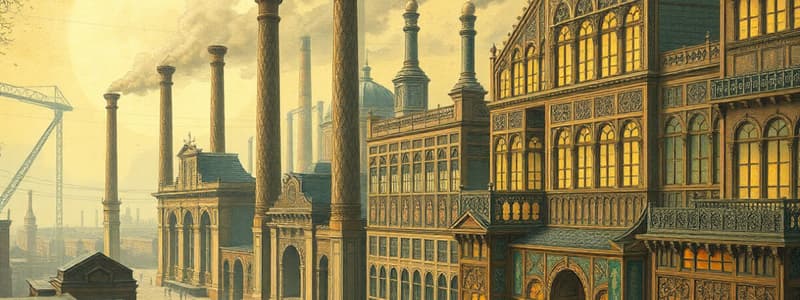Podcast
Questions and Answers
What was the population growth during the Industrial Revolution from 1750 to 1900?
What was the population growth during the Industrial Revolution from 1750 to 1900?
from 6.5 million to around 32.5 million
What major transformation occurred due to the Industrial Revolution?
What major transformation occurred due to the Industrial Revolution?
- Establishment of new factories and mills (correct)
- Expansion of rural areas
- Increase in agricultural production
- Introduction of steam power (correct)
Before the Industrial Revolution, more than 20% of people lived in cities.
Before the Industrial Revolution, more than 20% of people lived in cities.
False (B)
What became a vital supply during the Industrial Revolution?
What became a vital supply during the Industrial Revolution?
What led to improved transport and communication during the Industrial Revolution?
What led to improved transport and communication during the Industrial Revolution?
What type of social class emerged due to the Industrial Revolution?
What type of social class emerged due to the Industrial Revolution?
Around 80% of the population lived on small farms during the Industrial Revolution.
Around 80% of the population lived on small farms during the Industrial Revolution.
What was the main reason for the poor life expectancy during the Industrial Revolution?
What was the main reason for the poor life expectancy during the Industrial Revolution?
What were the two phases of the expansion of the British Empire?
What were the two phases of the expansion of the British Empire?
What factor provided a foundation for the Industrial Revolution to start in Britain?
What factor provided a foundation for the Industrial Revolution to start in Britain?
Match the Agricultural Revolution changes with their effects:
Match the Agricultural Revolution changes with their effects:
Flashcards are hidden until you start studying
Study Notes
The Beginning of The Industrial Revolution
- Population grew rapidly from 6.5 million in 1750 to 32.5 million in 1900.
- The Industrial Revolution led to the creation of thousands of factories and mills.
- These factories relied on large numbers of workers and machines to produce large quantities of goods.
- The emergence of factories led to the growth of modern towns and cities.
- Before the revolution, only 20% of the population lived in cities.
- New sources of power, such as steam power and electricity, transformed manufacturing and industries.
- Coal became a vital source of energy.
- Improved transport and communication systems emerged as pollution grew.
- New communication technologies and improved transport enabled people to travel and live less isolated lives.
- The rise of the middle class.
- People who were neither wealthy nor poor, such as bankers, teachers, doctors, and lawyers, could afford better living conditions.
- This led to an increase in the demand for schools, universities, and libraries.
Why the Industrial Revolution Began In Britain
- The expansion of the British Empire in two phases:
- The establishment of early British colonies in North America
- A series of wars fought between European powers in the 18th century.
- By 1900, the British Empire covered a quarter of the Earth's surface and ruled a quarter of the world's population.
- Britain's coal supply played a vital role in driving the Industrial Revolution, as coal was a primary fuel for steam power.
- Britain's naval power and trading power, supported by experienced and skilled sailors, played a significant role in the Revolution.
- Individual freedom and the capitalist spirit were crucial factors in enabling new methods and risk-taking in Britain.
- A stable government with limited political and social conflict encouraged business growth.
- Superior banking system that supported the expansion of trade.
The Agrarian/Agricultural Revolution
- Several changes in farming practices occurred across Britain from the mid-1600s.
- These changes are believed to be crucial for the eventual industrialization of the country.
- During the Agricultural Revolution, forests were cleared, and other spaces were transformed to grow crops.
- Agriculture became a business focused on generating profits.
- Farming conditions improved, with wheat production in Britain increasing by 75%.
- Large farms replaced smaller areas of land through enclosure laws.
- This led to private landowners taking control of land previously worked by local farmers.
- By 1790, three-quarters of the land was owned by wealthy landlords.
- Many farmers were forced to move abroad or to cities as a result.
- Despite the hardships, improved land management led to increased crop yields through crop rotation.
- The "4-field system" involved rotating crops each season to enrich the soil.
- Crops included wheat and barley for humans, and clover for grazing animals.
- Improved farm machinery, such as mechanical drills for planting seeds, harvesting machines, and threshing machines, increased farming efficiency and profits.
- Advancements in animal breeding and rearing, such as Robert Bakewell's quick-fattening sheep with finer wool and tastier meat, and cattle bred for beef production, transformed animal husbandry.
The Traditional Textile Industry
- The Industrial Revolution significantly improved the production of cotton, wool, coal, and iron.
- The most significant “invention” was a way of producing goods on a large scale.
- Before factories, work was done in small workshops or cottages.
- Workers would often work at home, using hand-operated tools and simple machinery.
- They often worked long hours for low wages.
- The development of factories led to the concentration of workers in one place, using large-scale machinery powered by steam or water.
- This resulted in increased production and efficiency, but also led to less individual control over the work process and worsened working conditions for many.
Studying That Suits You
Use AI to generate personalized quizzes and flashcards to suit your learning preferences.




